Officina Numbers on Late Roman Coins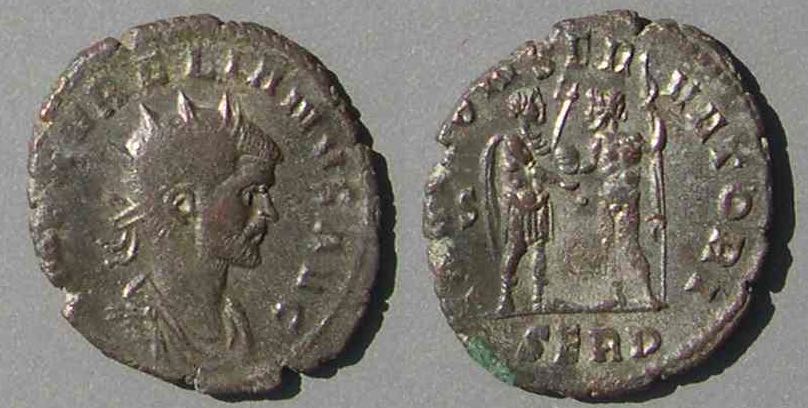
This web page illustrates an unusual method of identifying the officina number on late Roman coins--spelling it out in full: PRIMA, SECVNDA, TERTIA, QVARTA. (Skip down to that method.)
What is an Officina? A mint officina is a workshop -- a division of a mint ("officinae" is plural, "officina" singular). Roman mints were organized into parallel and non-overlapping workshops during the Republic and empire, but explicit indication of the officina number did not appear on coins until the third century AD and it is rare until the middle of the century. Before then, when Rome was the only mint, there was no reason to name the mint on coins because it could only be Rome. Under Gallienus (253-268) mints proliferated and mint marks to indicate mints began to appear. "M" for Milan (Mediolanum) was among the first. "SERD" for Serdica (modern Sophia, the capital of Bulgaria) was, under Aurelian (270-275) the first mint mark to spell out much of the mint name [coin at the upper right]. However, even as late as Aurelian the mint name is rarely explicit. However, officina numbers are frequently, but not always, indicated on coins of Aurelian.
What's new? 2025, Oct. 5: Gratian RPRIMA (rare).
2024, Dec. 3: Julian II with "OFF" in the mintmark.
It is first during the tetrarchy (which began under Diocletian, 284-305) that most Roman coins indicate their mint city, and when they do they usually also indicate the workshop within the mint. This is usually accomplished by attaching a Greek or Roman numeral to the mint mark in the exergue (the part below the low horizontal line on which the reverse type stands). Sometimes Roman numerals were used: I, II, III, IIII, V, VI. (By the way, IIII is typical for 4, not IV.)
The next coin has "VI" for "6".
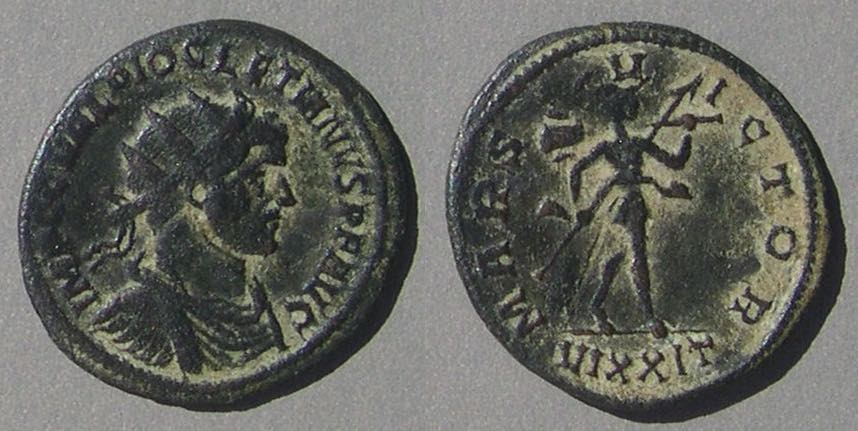 Diocletian, 284-305.
Diocletian, 284-305.
IMP C C VAL DIOCLETIANVS PF AVG
22-21 mm. Antoninianus
MARS VICTOR,
Mars advancing right with spear and trophy
Mint mark: VI XXI T
where the "T" is for Ticinum, the mint,
the "XXI" identifies the denomination
and the "VI" is 6, the officina number.
Sometimes Greek numerals were used. On the next coin "B" is used for "2".
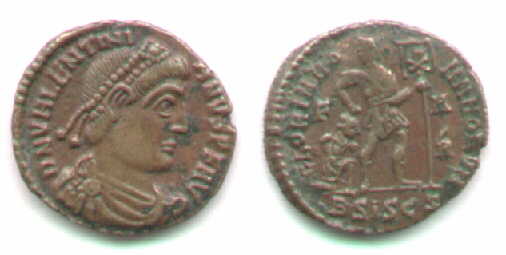 Valentinian, 364-375.
Valentinian, 364-375.
AE3, 18 milimeters in diameter.
DN VALENTINI-ANVS PF AVG
GLORIA ROMANORVM
emperor right, dragging captive, head turned back and holding labarum with chi-rho in left.
(One of the commonest Roman coin types)
Because in Greek A = 1 and B= 2, the marks ASISC and BSISC
indicate the first and second officinae at the mint Siscia (modern Sisak in Croatia).
This coin has BSISC.
Here is another way to indicate the officina number:
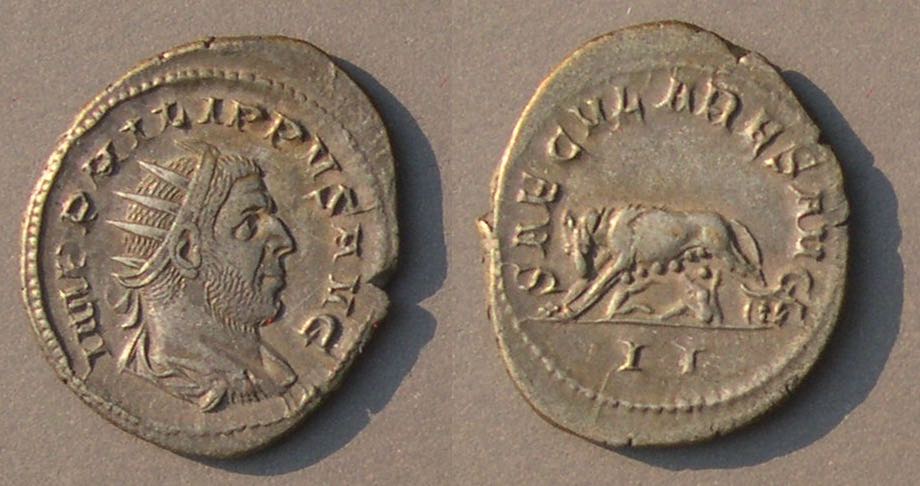 Philip I, 244-249 AD.
Philip I, 244-249 AD.
Silver antoninianus. 24-22 mm.
IMP PHILIPPVS AVG
SAECVLARES AVGG
wolf left and twins Romulus and Remus
Officina 2 (of six) clearly marked in exergue with the Roman numeral II.
Another, uncommon, methods of indicating the officina number was with dots. Some coins from Antioch have up to four dots below the obverse bust indicating officinae 1 through 4 and then Roman numerals for 5 through 7.
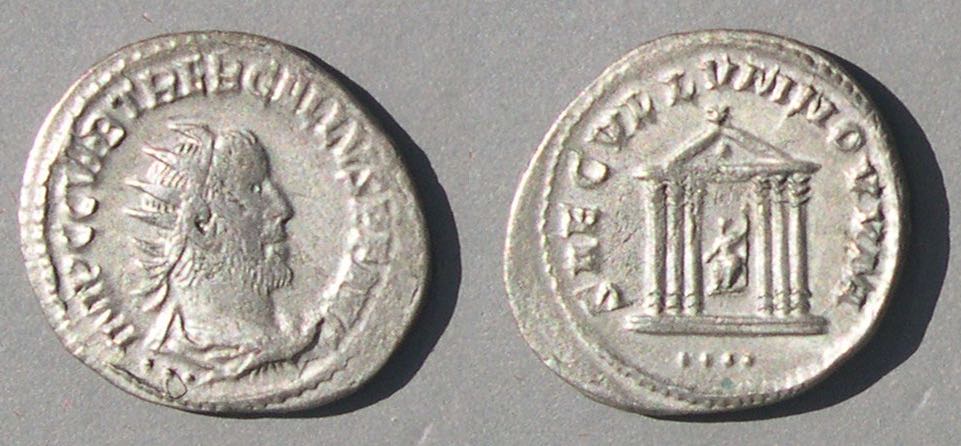 Trebonianus Gallus, 251-253
Trebonianus Gallus, 251-253
24-22 mm. 12:00. 4.11 grams.
IMP C C VIB TREB GALLUS PF AVG
His bust right with 4 dots below (the fourth is weak and joins the drapery)
SAECVLLVM NOVVM
temple of six columns, figure (Roma?) in center
four dots below
Antioch mint, fourth officina.
The next coin belongs to that series but does not have dots. It apparently has VII retrograde as IIV. Gert Boersema has an article on these on the web.
 Hostilian (250-251 AD)
Hostilian (250-251 AD)
as Augustus (summer 351 - November 351)
Mint of Antioch.
21 mm. Antoninianus.
SAECVLVM NOVVM
six-column temple, seated Roma within
Obverse legend:
C OVAL OSTIL MES COVINTVS AVG
IIV below the bust, indicating
the seventh officina (retrograde).
The Unusual Method used only at the Rome Mint

Mintmark R PRIMA (Rome, Prima) for the first officina at Rome.
Valens, co-emperor AD 365-378.
DN VALENS PF AVG
SECVRITAS REPVBLICAE, Victory advanced left with wreath and palm.
Spelling the officina number out in full (PRIMA, SECVNDA, TERTIA, QVARTA) as an ordinal number (First, Second, Third, Fourth) was used only on coins minted at Rome, and only for three Roman emperors (Valentinian, Valens, and Gratian) and only on two types, GLORIA ROMANORVM and SECVRITAS REPVBLICAE, during the period 364-375 AD. The standard reference numbers are RIC IX Rome 15 and 17 and then 23 and 24, which refer to the same type given two reference numbers in two time periods (In RIC IX when a single type is issued in two time periods, it gets a different number for each period, even if they cannot be distinguished.) The issue began under Valentinian and Valens in the period 364-367 and after the elevation of Gratian in 367 continued with all three emperors. It was not issued for Valentinian II who was elevated in 375, which is a terminus ante quem.
These two types were of the same denomination (called "AE3" in modern times, about 18 milimeters in diameter, the ancient name is uncertain) and were issued simultaneously and now often found together in large hoards. The two types are extremely common for Valentinian and Valens and very common for Gratian, especially from the mint of Siscia, but not so common from Rome, and many of these coins from Rome use a different method of indicating the officina (see below). The varieties with the officina number spelled out are scarce or rare. In each case, the number is preceded by an "R" for "Roma", the mint city.
GLORIA ROMANORNM
Emperor drags captive right
holds labarum in left hand
RIC 15 and 23 |
Valentinian I
(364-375 AD) |
Valens
(365-378 AD) |
Gratian
(367-383 AD) |
R PRIMA
(In most cases, clicking on the image
will yield a larger image.) |
 |
(Each cell in this table corresponds
to a variety. An empty cell merely
indicates I do not have an example
to show.) |
|
| R SECVNDA |
|
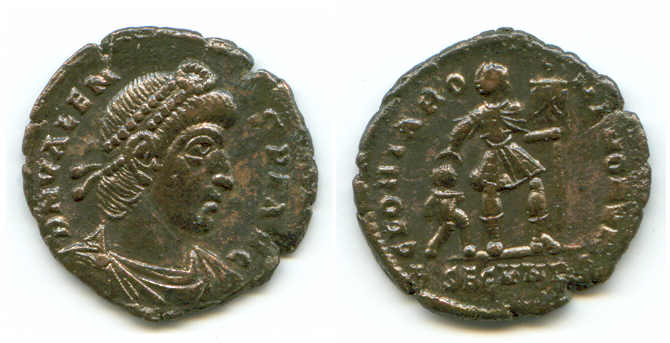 |
|
| R TERTIA |
 |
|
|
| R QVARTA |
no
image
|
|
|
SECVRITAS REIPVBLICAE
Victory advances left holding
out wreath in right hand
with palm branch in left
RIC 17 and 24 |
Valentinian I |
Valens |
Gratian |
| R PRIMA |
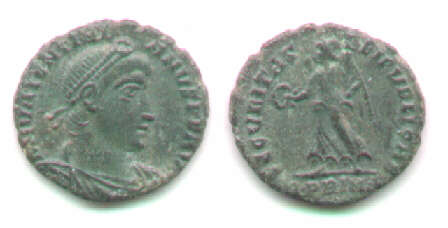 |
 |
 |
| R SECVNDA |
 |
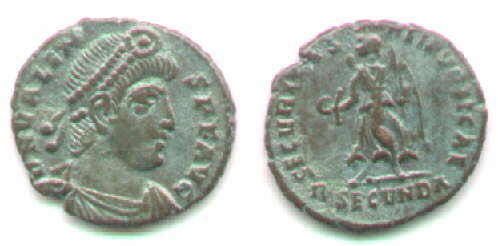 |
|
| R TERTIA |
|
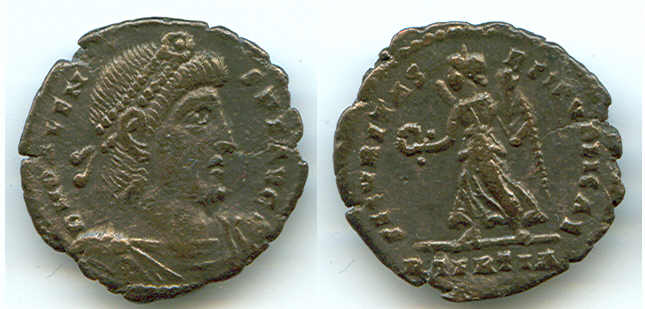 |
|
| R QVARTA |
 |
 |
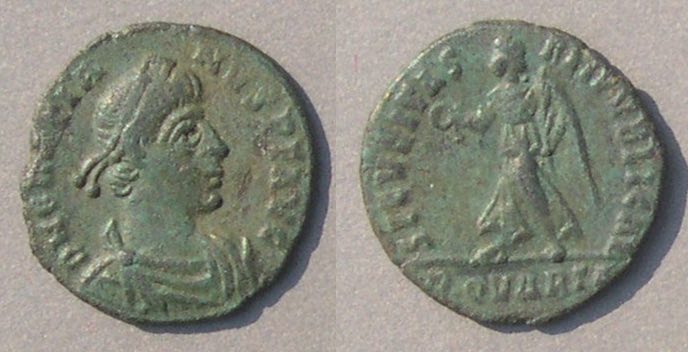 |
Rome was the only mint to spell out the officina number, but many coins from Rome, even of these types, do not use that system. Another way to indicate officina used at Rome was to use P for Prima = first, B for second (although we might expect S for Secunda = second), T for Tertia = third, and Q for Quarta = fourth.
 Gratian, 367-383
Gratian, 367-383
Rome mint.
DN GRATIA-NVS PF AVG
The second type above:
SECVRITAS REIPVBLICAS
Mint mark: SM <symbol> RP
where the symbol is heart or leaf shape.
"SM" is for "Sacra Moneta", "sacred mint"
"R" for "Rome" and "P" for Prima, first.
The word "officina" does not appear on Roman coins, but it is abbreviated on some unusual late issues:
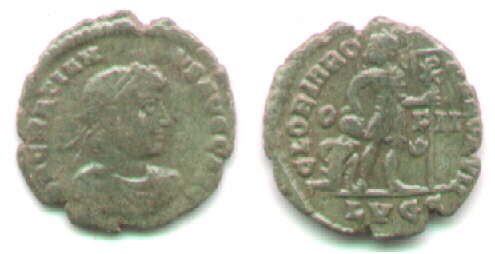 Gratian, 367-383
Gratian, 367-383
GLORIA ROMANORVM, of the second type above, but
from LVGS = Lugdunum = Lyons, officina 2, indicated by
O-F II
across the field
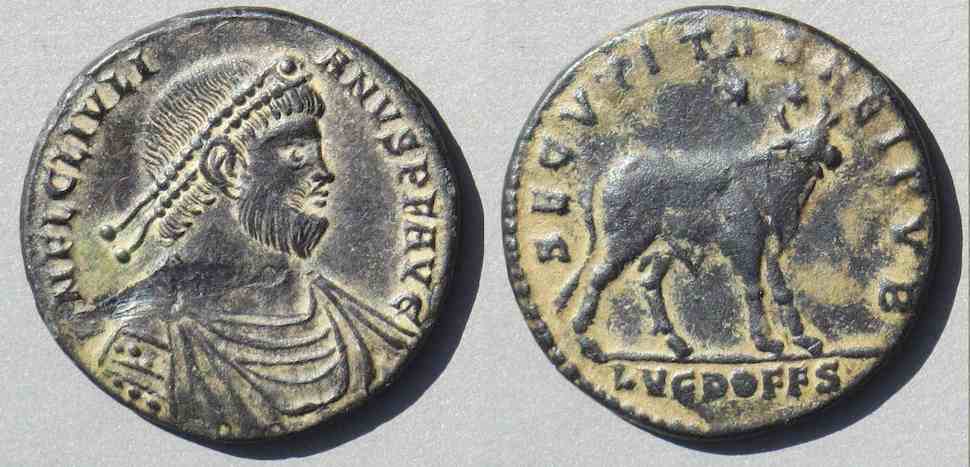 Julian II (The Apostate, or, The philosopher), Roman emperor 360-363 AD
27 mm. 9.07 grams.
Minted at Lyon, France, formerly Lugdunum, with
Julian II (The Apostate, or, The philosopher), Roman emperor 360-363 AD
27 mm. 9.07 grams.
Minted at Lyon, France, formerly Lugdunum, with
mintmark LVGD OFF S
where the abbrevition of "Lugdunum" is clear and the word
"Officina: is abbreviated (quite unusually--it is almost always omitted) and S refers to Secunda, the second officina.
The reverse type is SECVRITAS REIPVB, bull standing right with two stars above.
The obverse legend is
DN FL CL IVLI-ANVS PF AVG
for Flavius Claudius Julianus
RIC VIII Lugdunum 236
Related links:
Another unusual way to indicate the officinae. "Officina mintmarks of the Roman emperors Diocletian and Maximiman at Siscia (289-290 AD)"
Roman mints and a one coin illustrating one mark from each mint (not about officinae). "The Roman Numismatic Gallery"
Roman mints and all their basic marks (not about officinae): "Roman Mints"
Revised, Jan. 8, 2022. April 15, 2023. Dec. 3, 2024. Oct. 5, 2025.
Go to the main index page.
 Diocletian, 284-305.
Diocletian, 284-305.


















